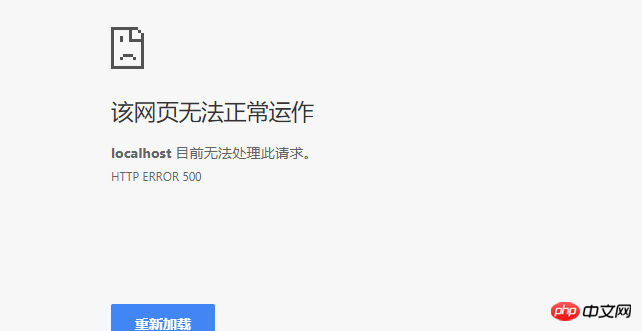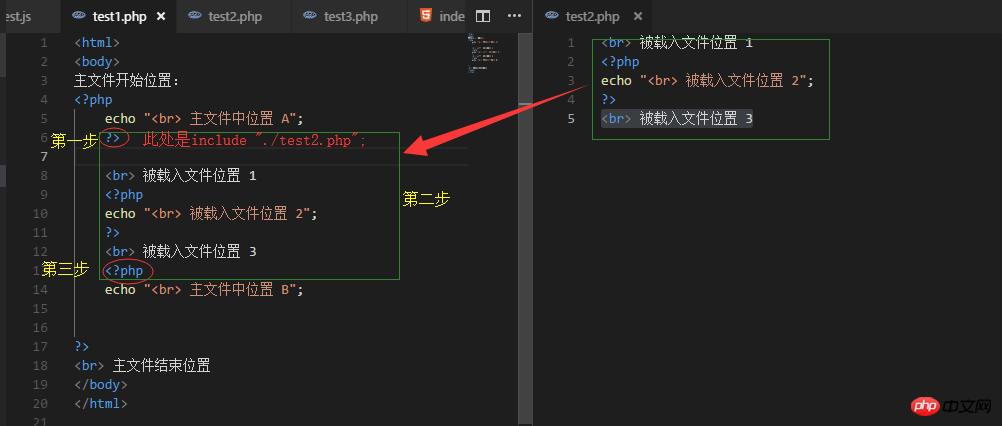PHP로 파일을 가져오는 방법은 무엇입니까? PHP에서 파일을 도입하는 네 가지 방법 소개(코드)
PHP에서 파일을 가져오는 방법은 무엇인가요? PHP 가져오기 파일에는 include, require, include_once, require_once의 네 가지 문이 있습니다. PHP 가져오기 파일의 구체적인 예를 살펴보겠습니다.
기본 구문
require: require 함수는 일반적으로 다음 위치에 배치됩니다. PHP 스크립트 앞부분에서 PHP는 require에 지정된 가져온 파일을 실행하기 전에 읽고 가져온 스크립트 파일을 포함하고 실행을 시도합니다. require가 작동하는 방식은 PHP의 실행 효율성을 높이는 것입니다. 동일한 웹 페이지에서 한 번 해석된 후에는 두 번째로 해석되지 않습니다. 그러나 마찬가지로 가져온 파일을 반복적으로 해석하지 않기 때문에 PHP에서 파일을 삽입하기 위해 루프나 조건문을 사용할 때 include를 사용해야 합니다.
include: 은 PHP 스크립트의 어느 곳에나 배치할 수 있으며 일반적으로 프로세스 제어의 처리 부분에 있습니다. include로 지정된 파일에 PHP 스크립트가 실행되면 해당 파일이 포함되어 실행을 시도합니다. 이 방법을 사용하면 프로그램 실행 과정을 단순화할 수 있습니다. 동일한 파일을 두 번째로 만나면 PHP는 이를 다시 해석합니다. 동시에 사용자 정의 함수가 가져온 파일에 포함되는 경우에는 include의 실행 효율성이 훨씬 낮습니다. PHP는 해석 과정에서 반복되는 함수 정의 문제를 겪게 됩니다.
require_once / include_once: 은 각각 require / include와 동일한 기능을 가지고 있지만 차이점은 실행 시 대상 콘텐츠를 먼저 가져왔는지 확인한다는 점입니다. 한 번 가져온 경우 동일한 콘텐츠를 다시 가져올 수 없습니다.
DIFFERENCE
include 및 require: # 🎜🎜#
include에는 반환 값이 있지만 require에는 반환 값이 없습니다. include는 파일 로드에 실패하면 경고(E_WARNING)를 생성하고 스크립트는 오류가 발생한 후에 실행됩니다. 실행을 계속합니다. 그래서 계속해서 실행하고 결과를 사용자에게 출력하고 싶을 때 include를 사용합니다.//test1.php
<?php
include './tsest.php';
echo 'this is test1';
?>
//test2.php
<?php
echo 'this is test2\n';
function test() {
echo 'this is test\n';
}
?>
//结果:
this is test1#결과 :#🎜🎜 ## ## ## ## ##### #####포함 및 include_once :#🎜🎜 ## 🎜🎜 ## 🎜🎜 # include로 로드된 파일은 중복 여부를 판단하지 않습니다. include 문이 있는 한, 반복 로드가 발생하더라도 한 번만 로드됩니다. include_once가 파일을 로드할 때 이전 코드가 로드되었는지 여부를 결정하는 내부 판단 메커니즘이 있습니다. 여기서 주목해야 할 점은 include_once는 파일의 내용(즉, 가져올 두 파일의 내용이 동일한 것)이 아닌 동일한 경로의 파일을 이전에 가져왔는지 여부를 기준으로 판단한다는 점입니다. , include_once를 사용하면 여전히 두 가지가 발생합니다).
//test1.php
<?php
require './tsest.php';
echo 'this is test1';
?>
//test2.php
<?php
echo 'this is test2\n';
function test() {
echo 'this is test\n';
}
?>include와 include_once의 차이점과 동일합니다. 
로드 시 실행 프로세스
1. include(필수) 문에서 php 스크립트 모드를 종료합니다. html 코드 모드 진입)2. include 문으로 설정된 파일에 코드를 로드하고
3을 실행해 보세요. mode , 다음 스크립트 프로그램 실행을 계속합니다//test1.php <?php include './test2.php'; echo 'this is test1'; include './test2.php'; ?> //test2.php <?php echo 'this is test2'; ?> //结果: this is test2this is test1this is test2 //test1.php <?php include './test2.php'; echo 'this is test1'; include_once './test2.php'; ?> //test2.php <?php echo 'this is test2'; ?> //结果: this is test2this is test1 //test1.php <?php include_once './test2.php'; echo 'this is test1'; include './test2.php'; ?> //test2.php <?php echo 'this is test2'; ?> //结果: this is test2this is test1this is test2 //test1.php <?php include_once './test2.php'; echo 'this is test1'; include_once './test2.php'; ?> //test2.php <?php echo 'this is test2'; ?> //结果: this is test2this is test1

상대 경로:
#🎜 🎜# 현재 웹 페이지 파일의 위치를 기준으로 로드된 파일의 위치를 찾습니다.
현재 웹 페이지 파일의 위치를 기준으로 로드된 파일의 위치를 찾습니다.
//test1.php
<html>
<body>
主文件开始位置:
<?php
echo "<br> 主文件中位置 A";
include "./test2.php"; //要载入的文件
echo "<br> 主文件中位置 B";
?>
<br> 主文件结束位置
</body>
</html>
//test2.php
<br> 被载入文件位置 1
<?php
echo "<br> 被载入文件位置 2";
?>
<br> 被载入文件位置 3절대 경로:
로컬 절대 경로와 네트워크 절대 경로로 구분됩니다#🎜🎜 ## 🎜🎜# 로컬 절대 경로: 해당 디렉터리에서 가져올 파일을 찾을 때까지 로컬 루트 디렉터리에서 레이어별로 반복적으로 검색합니다.
./ 表示表示当前位置,即当前网页文件所在的目录 . . / 表示上一级位置,即当前网页文件所在目录的上一级目录 //例如: include "./test2.php"; require "../../test3.html";
우리 모두는 절대 경로가 프로젝트의 이식성과 유지 관리에 도움이 되지 않는다는 것을 알고 있으므로 일반적으로 코드에 직접 절대 경로를 작성하는 경우는 없지만 필요한 경우 어떻게 해야 합니까? 절대 경로를 사용합니까? ? PHP에는 마법 상수 __DIR__ 및 전역 배열 $_SERVER가 있습니다. 사용법은 다음과 같습니다:
include "C:/PHP/test/test2.php";
절대 네트워크 경로: 링크 by URL 해당 파일 아래에서 서버는 URL이 가리키는 파일을 실행하고 반환합니다. 이때 PHP는 현재 웹 페이지 디렉터리에서 해당 파일을 찾습니다. 실행되어 수입됩니다.
需要注意:无论采用哪种路径,必须要加上文件后缀名,这四种文件载入方式不能识别无后缀的文件。
//test1.php include "./test2.php"; //结果:this is test2 //test1.php include "./test2"; //结果:
返回值的比较
上文说道include有返回值,而require无返回值
对于include,如果载入成功,有返回值,返回值为1;如果载入失败,则返回false.
对于require,如果载入成功,有返回值,返回值为1;如果载入失败,无返回值。
//test1.php <?php $a = include "./test2.php"; var_dump($a); echo "<br>"; $b = include "./test2.phps"; var_dump($b); echo "<br>"; $c = require "./test2.php"; var_dump($c); echo "<br>"; $d = require "./test2.phps"; var_dump($d); ?>
输出:

当文件中有return:
当被载入文件中有return语句时,会有另外的机制,此时return语句的作用是终止载入过程,即被载入文件中return语句的后续代码不再载入。return语句也可以用于被载入文件载入时返回一个数据。
//test1.php <?php $a = include "./test2.php"; echo "<br>"; var_dump($a); ?> //test2.php //该文件中有return语句 <?php $b = 'test2'; echo "被载入的文件:A 位置"; return $b; echo "<br 被载入的文件: B 位置"; ?>
结果:

相关推荐:
php 字符串写入文件或追加入文件(file_put_contents)
위 내용은 PHP로 파일을 가져오는 방법은 무엇입니까? PHP에서 파일을 도입하는 네 가지 방법 소개(코드)의 상세 내용입니다. 자세한 내용은 PHP 중국어 웹사이트의 기타 관련 기사를 참조하세요!

핫 AI 도구

Undresser.AI Undress
사실적인 누드 사진을 만들기 위한 AI 기반 앱

AI Clothes Remover
사진에서 옷을 제거하는 온라인 AI 도구입니다.

Undress AI Tool
무료로 이미지를 벗다

Clothoff.io
AI 옷 제거제

AI Hentai Generator
AI Hentai를 무료로 생성하십시오.

인기 기사

뜨거운 도구

메모장++7.3.1
사용하기 쉬운 무료 코드 편집기

SublimeText3 중국어 버전
중국어 버전, 사용하기 매우 쉽습니다.

스튜디오 13.0.1 보내기
강력한 PHP 통합 개발 환경

드림위버 CS6
시각적 웹 개발 도구

SublimeText3 Mac 버전
신 수준의 코드 편집 소프트웨어(SublimeText3)

뜨거운 주제
 7563
7563
 15
15
 1385
1385
 52
52
 84
84
 11
11
 61
61
 19
19
 28
28
 99
99
 ALIPAY PHP SDK 전송 오류 : '클래스 부호 데이터를 선언 할 수 없음'의 문제를 해결하는 방법은 무엇입니까?
Apr 01, 2025 am 07:21 AM
ALIPAY PHP SDK 전송 오류 : '클래스 부호 데이터를 선언 할 수 없음'의 문제를 해결하는 방법은 무엇입니까?
Apr 01, 2025 am 07:21 AM
Alipay PHP ...
 JWT (JSON Web Tokens) 및 PHP API의 사용 사례를 설명하십시오.
Apr 05, 2025 am 12:04 AM
JWT (JSON Web Tokens) 및 PHP API의 사용 사례를 설명하십시오.
Apr 05, 2025 am 12:04 AM
JWT는 주로 신분증 인증 및 정보 교환을 위해 당사자간에 정보를 안전하게 전송하는 데 사용되는 JSON을 기반으로 한 개방형 표준입니다. 1. JWT는 헤더, 페이로드 및 서명의 세 부분으로 구성됩니다. 2. JWT의 작업 원칙에는 세 가지 단계가 포함됩니다. JWT 생성, JWT 확인 및 Parsing Payload. 3. PHP에서 인증에 JWT를 사용하면 JWT를 생성하고 확인할 수 있으며 사용자 역할 및 권한 정보가 고급 사용에 포함될 수 있습니다. 4. 일반적인 오류에는 서명 검증 실패, 토큰 만료 및 대형 페이로드가 포함됩니다. 디버깅 기술에는 디버깅 도구 및 로깅 사용이 포함됩니다. 5. 성능 최적화 및 모범 사례에는 적절한 시그니처 알고리즘 사용, 타당성 기간 설정 합리적,
 확실한 원칙과 PHP 개발에 적용되는 방법을 설명하십시오.
Apr 03, 2025 am 12:04 AM
확실한 원칙과 PHP 개발에 적용되는 방법을 설명하십시오.
Apr 03, 2025 am 12:04 AM
PHP 개발에서 견고한 원칙의 적용에는 다음이 포함됩니다. 1. 단일 책임 원칙 (SRP) : 각 클래스는 하나의 기능 만 담당합니다. 2. Open and Close Principle (OCP) : 변경은 수정보다는 확장을 통해 달성됩니다. 3. Lisch의 대체 원칙 (LSP) : 서브 클래스는 프로그램 정확도에 영향을 미치지 않고 기본 클래스를 대체 할 수 있습니다. 4. 인터페이스 격리 원리 (ISP) : 의존성 및 사용되지 않은 방법을 피하기 위해 세밀한 인터페이스를 사용하십시오. 5. 의존성 반전 원리 (DIP) : 높고 낮은 수준의 모듈은 추상화에 의존하며 종속성 주입을 통해 구현됩니다.
 시스템 재시작 후 UnixSocket의 권한을 자동으로 설정하는 방법은 무엇입니까?
Mar 31, 2025 pm 11:54 PM
시스템 재시작 후 UnixSocket의 권한을 자동으로 설정하는 방법은 무엇입니까?
Mar 31, 2025 pm 11:54 PM
시스템이 다시 시작된 후 UnixSocket의 권한을 자동으로 설정하는 방법. 시스템이 다시 시작될 때마다 UnixSocket의 권한을 수정하려면 다음 명령을 실행해야합니다.
 PHP에서 늦은 정적 결합의 개념을 설명하십시오.
Mar 21, 2025 pm 01:33 PM
PHP에서 늦은 정적 결합의 개념을 설명하십시오.
Mar 21, 2025 pm 01:33 PM
기사는 PHP 5.3에 도입 된 PHP의 LSB (Late STATIC BING)에 대해 논의하여 정적 방법의 런타임 해상도가보다 유연한 상속을 요구할 수있게한다. LSB의 실제 응용 프로그램 및 잠재적 성능
 PHP의 CURL 라이브러리를 사용하여 JSON 데이터가 포함 된 게시물 요청을 보내는 방법은 무엇입니까?
Apr 01, 2025 pm 03:12 PM
PHP의 CURL 라이브러리를 사용하여 JSON 데이터가 포함 된 게시물 요청을 보내는 방법은 무엇입니까?
Apr 01, 2025 pm 03:12 PM
PHP 개발에서 PHP의 CURL 라이브러리를 사용하여 JSON 데이터를 보내면 종종 외부 API와 상호 작용해야합니다. 일반적인 방법 중 하나는 컬 라이브러리를 사용하여 게시물을 보내는 것입니다 ...
 프레임 워크 보안 기능 : 취약점 보호.
Mar 28, 2025 pm 05:11 PM
프레임 워크 보안 기능 : 취약점 보호.
Mar 28, 2025 pm 05:11 PM
기사는 입력 유효성 검사, 인증 및 정기 업데이트를 포함한 취약점을 방지하기 위해 프레임 워크의 필수 보안 기능을 논의합니다.
 phpstorm에서 CLI 모드를 디버그하는 방법은 무엇입니까?
Apr 01, 2025 pm 02:57 PM
phpstorm에서 CLI 모드를 디버그하는 방법은 무엇입니까?
Apr 01, 2025 pm 02:57 PM
phpstorm에서 CLI 모드를 디버그하는 방법은 무엇입니까? PHPStorm으로 개발할 때 때때로 CLI (Command Line Interface) 모드에서 PHP를 디버그해야합니다 ...




